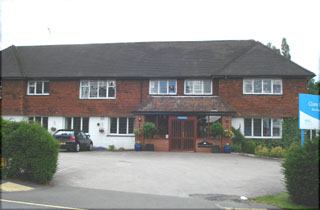General. Later, chronic
After the Crimean War and Florence Nightingale's success in nursing, wealthy ladies began to take a philanthropic interest in medicine.
In Uxbridge, the daughter of a local banker and landowner, Miss Laura Cox, campaigned for the establishment of a hospital for the area. The Cox family donated two small cottages in Park Road, and the Hillingdon and Uxbridge Cottage Hospital was born in 1869.
In 1879 the Hospital moved to larger premises in Park Road. As with other cottage hospitals, no child under 4 years of age was admitted, nor any patient with TB, infectious or chronic disease , nor any with ulceration of the legs or epilepsy.
In 1914 it moved again, this time to Harefield Road. The Cox family, together with Lord and Lady Hillingdon and Lady Essex, had accepted financial responsibility for the equipping and staffing of the Hospital, but at the outbreak of WW1, the Coxes moved to southern England. The townspeople of Uxbridge then took on the duties and maintenance of their 'community hospital'.
After the war the Hospital was extended - a new wing was added in 1925, providing a new female ward and a larger dining/sitting room for the staff. In 1925 the weekly charge for a private patient room was 5 guineas (£5.25).
Another wing was built in 1929 and an operating theatre installed.
At the beginning of WW2 a First Aid station was established by the ARP to deal with civilian casualties. The Ministry of Health reserved some of the Hospital's 22 beds but, by May 1941, the Ministry released the Hospital from its obligations. The First Aid station was removed, but the Hospital remained a unit of the Emergency Medical Scheme. Two private rooms were added, giving it 23 beds.
In September 1943 a new X-ray apparatus was installed. An adjacent piece of land was purchased for future extension of the Hospital.
In 1948 the Hospital joined the NHS as the Uxbridge and District Cottage Hospital, under the control of the Uxbridge Group Hospital Management Committee, part of the North West Metropolitan Regional Hospital Board. It became a GP hospital with 24 beds.
In 1951 a small ward of 4 children's cots was established for patients from Hillingdon Hospital undergoing tonsil and adenoid removal. ENT surgeons from Hillingdon Hospital were sent to perform the operations.
By 1954 the Hospital had 27 beds, a small Out-Patients Department and an X-ray Department. Six beds were kept for pre-convalescent patients from Hillingdon Hospital (the Cottage Hospital called these 'chronic beds'). A further 6 beds were reserved for tonsil and adenoid cases. The patients from Hillingdon Hospital could not be discharged by Cottage Hospital staff.
In 1957 the weekly cost of an in-patient was £15 8s 11d (£15.45).
In 1961 the operating theatre was extended and the autoclave room enlarged. The sluice room on the first floor was also replanned and re-equipped. A Day Room for the female ward was built on the flat roof over the nurses' quarters, and opened on 17th July 1961. Six beds were made available for GP use, if they were not required by the Hillingdon Hospital consultants.
In August 1963 the Hospital was closed so that building and engineering works could be carried out. The main entrance was improved.
By 1968 it had become the Uxbridge and District Hospital.
In 1974, following a major reorganisation of the NHS, it came under the control of the Hillingdon District Health Authority, part of the North West Thames Regional Health Authority.
In 1976 the Health Authority proposed to close it. Nothing happened for two years until the Hospital was closed temporarily for redecoration and the installation of a new lift. The patients were moved to a ward in the Hillingdon Hospital. It was then decided to house the Hospital's services in the specially named Uxbridge Ward at Hillingdon Hospital.
Thus, the Uxbridge and District Hospital closed in 1978.
Present status (July 2008)
The former Hospital is now Clare House, a BUPA Care Home. It has its own bus stop.


Park Road, the original site of the Hillingdon and Uxbridge Cottage Hospital.

Clare House, as seen from across Harefield Road
Wingfield H 2003 The workhouse and hospital at Hillingdon (Middlesex) 1744-1967. London, Hillingdon Hospital NHS Trust.
http://hansard.millbanksystems.com
www.theyworkforyou.com
Return to home page